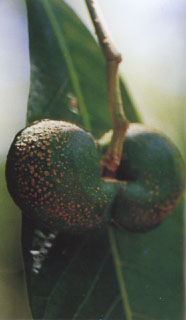- Apocynaceae - Tropical zones in Africa
 |
Botanical information
An evergreen tree, it grows to a height of 6m with a spread of 2m, but is usually kept smaller in cultivation. The stem is erect and branching, the leaves are broadly oval and up to 30cm long; the fruit are berries containing several brown seed which are irregularly shaped, the cluster somewhat resembling a brain.
A native of the West African rainforests, it prefers well composted rich soils in a protected sunny to part shade position, and is drought and frost tender.
Propagation is from fresh seed or cuttings. Sterilise seed in 6% hydrogen peroxide for 10 mintues, then plant about 10mm deep in sterilised sand or seedraising mix. Application of a systemic fungicide may be needed to control fungal infections which readily spread from unviable seed. Fresh seed germinates much quicker than older seed.
Pharmacology
As a close relative of Tabernanthe iboga and many other psychoactive members of the Apocynaceae, Voacanga species are generally ingested to increase endurance and stamina and also for magic and religious purposes. The seeds of Voacanga africana contain up to 10% indolealkaloids, including voacamine, voacangine and many related compounds. The same alkaloids are found in the bark, but in much lower levels (~2%). This group of indole alkaloids when ingested causes a mild to strong stimulation lasting several hours. Higher doses have a strong hallucinogenic effect.
TRADITIONAL PREPARATION: Voacanga africana is one of the well guarded secrets of the African Magic Healers. Little is know about the actual use of the seeds and the bark of several Voacanga species (including V.africana), other than that the plant is held in high esteem for ritual purposes. The use of seeds for visionary experiences has been documented.
http://www.entheology.org/